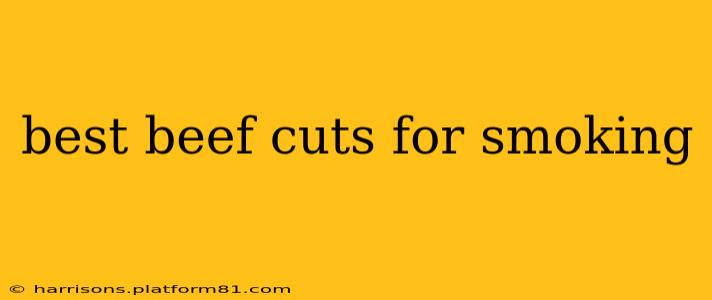Smoking beef is a culinary adventure that yields incredibly flavorful results. However, not all beef cuts are created equal when it comes to smoking. Some cuts are better suited to low-and-slow smoking due to their higher collagen content, while others benefit from a quicker smoke for optimal tenderness and flavor. This guide explores the best beef cuts for smoking, helping you choose the perfect cut for your next barbecue masterpiece.
What Makes a Cut of Beef Ideal for Smoking?
Before we dive into specific cuts, it's helpful to understand what characteristics make a beef cut perfect for smoking. Generally, cuts with more connective tissue (collagen) benefit most from low-and-slow smoking. The long cooking time breaks down this collagen, resulting in incredibly tender, juicy meat. Conversely, leaner cuts can dry out during long smoking sessions.
Best Beef Cuts for Low-and-Slow Smoking
These cuts are tougher but benefit greatly from the extended cooking time and low temperatures of smoking. They'll become incredibly tender and flavorful.
1. Brisket: The King of Smoked Beef
The brisket is undeniably the champion of smoked beef. Its rich marbling and high collagen content transform into melt-in-your-mouth tenderness after a long smoke. Expect a flavorful, juicy result that's perfect for slicing and serving.
2. Chuck Roast: A Budget-Friendly Favorite
The chuck roast is a more affordable option that still delivers exceptional results when smoked. It's a flavorful cut that benefits immensely from low-and-slow cooking, resulting in a pull-apart texture perfect for sandwiches or tacos.
3. Short Ribs: Rich, Bone-In Delight
Short ribs, whether bone-in or boneless, are another excellent choice for smoking. The bone adds flavor, and the rich marbling ensures a juicy, tender result. They’re perfect for individual servings or sharing.
4. Beef Shank: A Surprisingly Tender Cut
Don't overlook the beef shank! This cut is often overlooked but produces incredibly tender, flavorful results when smoked low and slow. It’s a great option for those seeking a unique smoking experience.
Best Beef Cuts for Faster Smoking
These cuts are leaner and benefit from shorter smoking times to prevent them from drying out. They still achieve great flavor, just with a quicker process.
5. Ribeye: A Marbled Classic
The ribeye is known for its rich marbling and excellent flavor. While it can handle a longer smoke, a shorter time keeps it juicy and prevents it from becoming too dry. A reverse sear after smoking is a great method here.
6. Sirloin: Lean and Flavorful
Sirloin is a leaner cut that's perfect for those who prefer less fat. It benefits from a shorter smoke to retain its moisture and tenderness. Marinades or rubs are key to maximizing flavor.
7. Flank Steak: Quick Smoke, Big Flavor
Flank steak is a lean, flavorful cut that’s ideally suited to faster smoking methods. Its relatively thin shape ensures even cooking and quick smoking time. It's delicious sliced thinly against the grain.
What Temperature Should I Smoke Beef At?
The ideal temperature for smoking beef depends on the cut. Generally, low-and-slow smoking for tougher cuts (like brisket, chuck roast, short ribs, and shank) is done at temperatures between 225°F and 250°F (107°C and 121°C). Leaner cuts can tolerate slightly higher temperatures, but still benefit from staying below 300°F (149°C).
How Long Does it Take to Smoke Beef?
Smoking times vary considerably depending on the cut and size of the meat. Tougher cuts often require 12-18 hours or even longer, while leaner cuts can be smoked in 3-6 hours. Always use a meat thermometer to ensure the beef reaches a safe internal temperature.
What Wood Should I Use for Smoking Beef?
Choosing the right wood for smoking beef can significantly impact the final flavor. Popular options include hickory, mesquite, oak, and pecan. Experiment with different woods to discover your personal preference.
Can I Smoke Beef Without a Smoker?
While a smoker is ideal, you can achieve a smoky flavor using other methods like a grill with a smoker box or even by using liquid smoke. However, the results won't be identical to a dedicated smoker.
This guide provides a starting point for your smoking adventures. Remember to always consult reliable recipes and cooking guides for specific cooking times and temperatures based on your chosen cut and equipment. Happy smoking!
